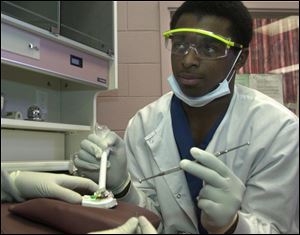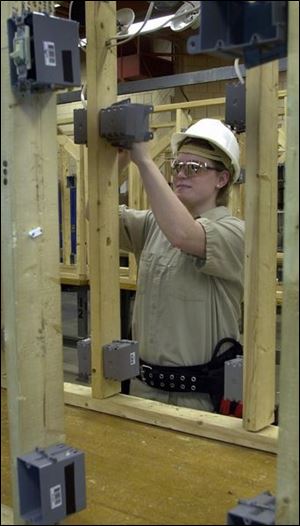
Young people are crossing the gender line in vocational education classes
11/17/2002
Amanda Perlewitz, 17, works on a residential stud wall in her class at Penta Career Center.
BLADE

Angela Glambin, a senior from Luckey, sands a car in the automotive collision repair lab at Penta Career Center.
The road less traveled is getting a little more traffic.
Angela Glambin, 17, is on her way to a career in automotive collision repair. Amanda Perlewitz, 17, is studying construction electricity. Eden Fouts, 18, is in security and law enforcement. Brandon Daniels, 17, is enrolled in a dental assistant program.
These seniors at the Penta Career Center in Perrysburg are among the kids who cross traditional gender lines in career-technical training programs, today's term for vocational education.
“I didn't want to have a sit-down job,” says Amanda, of Holland. She wanted action. She wanted good money. And she didn't want to follow her brothers into carpentry.
“I wanted to take a risk,” she says.
Jane Music, supervisor of career development and career pathways at Penta, says many of the school's training programs have a fairly even mix of males and females. Although the numbers change from year to year, marketing education is an example.

Brandon Daniels, a Penta senior from Northwood, is in the dental assistant program.
Gains are being made in other areas, she says, including security and law enforcement, landscape and turf grass management, and culinary arts.
In the Toledo Public Schools, there's a smattering of girls in such programs as welding, construction, and electrical trades, and a few more boys are in female strongholds such as health occupations, according to Kevin McCann, director of the career technology department. “I think we're seeing some inroads,” he says.
Some would say that, nationwide, it's not nearly enough.
“The statistics look remarkably similar to what they were 30 years ago,” says Jocelyn Samuels, vice president and director, educational opportunities, for the National Women's Law Center in Washington. “There may have been some changes at the margins, and my hope would be that girls and boys are more aware of their rights and of the options that could potentially be available to them, but in terms of actual experience there has been virtually no change since Title IX was enacted,” she declares.
Title IX is the federal law passed in June, 1972, that bars sex discrimination in all aspects of federally funded education.
The National Women's Law Center, a nonprofit advocacy group, filed legal petitions last summer with the Department of Education's Office for Civil Rights, requesting investigations of “sex discrimination in vocational and technical education across the country.”
In announcing its step June 6, the center said that “boys are still being steered toward courses that lead to traditionally male, and higher paying, careers in technology and the trades, while girls are clustered in programs that lead to lower-paying jobs in cosmetology, child care, and the like.”

Amanda Perlewitz, 17, works on a residential stud wall in her class at Penta Career Center.
The center says 96 percent of cosmetology students are female, as are 87 percent of those enrolled in child care courses, while boys make up more than 90 percent of students in carpentry, automotive, and plumbing.
“Those kinds of stark patterns of sex segregation cannot be the product of choice alone,” Ms. Samuels contends. She blames subconsciously biased counseling, sex stereotyping, failure to make sure girls and their parents are informed about the economic consequences of career choices, harassment from other students, and occasional messages from teachers that girls aren't taken seriously.
The women's center learned of one case, for example, in which “The teacher asked the girls to sweep up in the lab while the boys finished the experiment,” Ms. Samuels relates.
Mr. McCann, of the TPS career programs, admits he's frustrated by the gender divide. He's especially vexed by male domination of a new information technology program at Bowsher High School.
“We have a brand-new employment opportunity and career field, and it's starting to segregate itself,” he says. “The gender issue just baffles me. Historically, there have been some real biases, such as in the construction trades, but this one really bothers me because this is a new field.”
Mr. McCann says he conducted informal research on the issue with his daughter, a senior at Bowsher, and a group of her friends. “They all said, `No, we wouldn't feel inhibited about going into a program like that. We're just not interested,'” he reports.
He's looking for solutions, but wonders how to overcome societal and cultural influences on career choices.
“I feel very comfortable that nobody is overtly segregating students,” Mr. McCann says. “Some kids are just biased. [They think] `that's a boy job' and they just don't want to do that.”
Mr. McCann says one way the district tries to promote inclusion is to picture a cross-section of students in career-technology marketing materials.
At Penta, Mrs. Music says 10th graders who attend the annual “Explore Penta Days” are instructed to visit three programs of their choice. “We encourage them to choose one nontraditional program, so we're kind of telling them to take a stretch, try to picture yourself in an area you hadn't considered.”
But making career fields gender-neutral isn't just the responsibility of vocational education, Mrs. Music points out. Employers, parents, and guidance counselors have to help, too, she says.
Penta student Eden Fouts, of Weston, Ohio, is learning law-and-order basics, including how to handcuff and fingerprint suspects, write a crime report, and make traffic stops. She chose the security and law enforcement program, she explains, because “I thought it would be a wonderful way to jump-start my career and find out what I was getting into.”
Of the 15 seniors in security and law enforcement, three are females. Her parents and teachers are supportive, she says, as are the boys in the class. “We're really good buddies with most of the guys.”
Eden, who has pet snakes and dyed her hair green two years ago, says she likes doing things her own way. “Everyone tells me that I don't quite follow the crowd,” she says.
Brandon Daniels, of Northwood, is the lone male out of 16 students in the senior year of the dental assistant program. “I enjoy it. It's nothing to be ashamed of,” he says, adding that the only teasing he gets is on the days the dental students wear purple scrubs. “They call me Barney,” he admits.
“I wanted to be a dentist when I was younger,” Brandon says. He chose the dental assistant program, he explains, “to get an idea of what I wanted to do in life.”
For Amanda Perlewitz, the choice was construction electricity - and she says it's been rough. There are 19 seniors in the program; she's the only female.
Boys haven't welcomed her warmly on what they regard as their turf. “I have to show them I can do stuff,” says Amanda. She feels she has to work harder to prove herself, but says she has never considered leaving the program.
“I'm strong-willed,” she continues. “I did cry a few times, but I won't quit for anyone else.”
Angela Glambin, of Luckey, says she considered enrolling in automotive technology and cosmetology before deciding on automotive collision repair. “I wanted something fun and interesting. Also, I like art a lot, and I like to take something and re-do it,” she says.
“It's more fun than I thought it would be. I kind of zone off in my own little world when I'm doing it,” she adds. One of three girls among 15 seniors in the program, she says the boys in the class “treat me like one of them.”
And the coveralls she usually wears in her lab sessions get a thumbs-up from her girlfriends.
“They say, `Oh Ang, you look so cute!'”